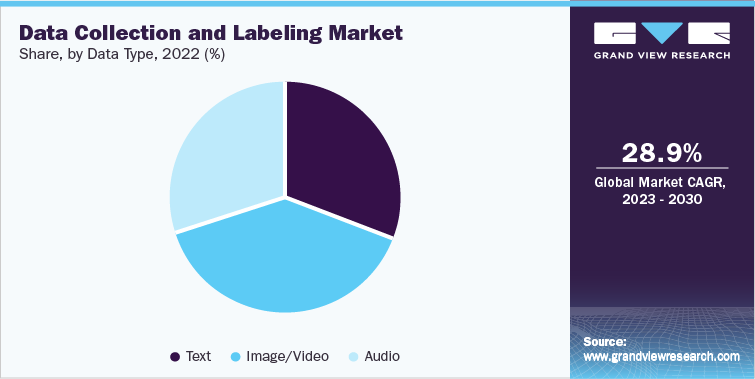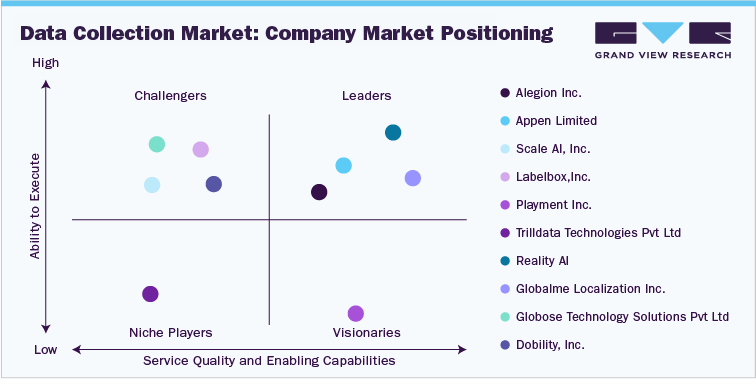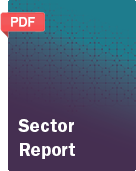- Home
- »
- Sector Reports
- »
-
Data Collection and Labeling Industry Data Book, 2023-2030
Database Overview
Grand View Research’s data collection and labeling sector data book is a collection of market sizing information & forecasts, competitive benchmarking analyses, macro-environmental analyses, and regulatory & technological framework studies. Within the purview of the database, all such information is systematically analyzed and provided in the form of presentations and detailed outlook reports on individual areas of research.
The following data points will be included in the final product offering in 2 reports and one sector report overview:
Data Collection and Labeling Industry Data Book Scope
Attribute
Details
Research Areas
- Data Collection Market
- Data Labeling Market
Number of Reports/Deliverables in the Bundle
- 2 Individual Reports-PDF
- 2 Individual Reports-Excel
- 1 Sector Report-PPT
- 1 Databook-Excel
Cumulative Country Coverage
30 countries coverage
Cumulative Product Coverage
30+ Level 1 & 2 Products
Highlights of Datasets
- Data Type Revenue, by Country
- Vertical Revenue, by Country
Total number of Tables (Excel) in the Bundle
132
Total Number of Figures in the Bundle
75+
Data Collection and Labeling Industry Data Book Coverage Snapshot
Markets Covered
Data Collection and Labeling Industry
USD 2.22 billion in 2022
28.9% CAGR (2023-2030)
Data Collection Market Size
USD 1.41 billion in 2022
30.1% CAGR (2023-2030)
Data Labeling Market Size
USD 0.81 billion in 2022
26.5% CAGR (2023-2030)
Data Collection and Labeling Sector Outlook
The global market size for data collection and labeling was estimated at USD 2.22 billion in 2022 and is anticipated to grow at a CAGR of 28.9% from 2023 to 2030. The combination bundle is designed to provide a holistic view of these highly dynamic market spaces. Further, the market is expected to witness a surge in technology adoption owing to benefits such as extracting business insights from socially shared pictures and auto-organizing untagged photo collections.

With the growing implementation of Electronic Health Record (EHR) systems, the accumulation of clinical data, including unstructured text documents, has become one of the valuable resources for clinical research. Statistical Natural Language Processing (NLP) models have been developed to unlock information embedded in clinical text. Additionally, text labeling is highly utilized in social media monitoring due to improvements in sentiment analysis. E-commerce companies use social media data to influence their customers to purchase. By utilizing image labeling, consumers shopping online can search for clothing or accessories by simply taking a picture of the desired texture, print, or color using their smartphone. The captured photo is uploaded to an app that uses AI technology to search an inventory of products and find similar items based on the visual characteristics of the uploaded image.
Data Collection Market Analysis & Forecast
The global data collection market size was valued at USD 1.41 billion in 2022 and is expected to grow at a compound annual growth rate (CAGR) of 30.1% from 2023 to 2030. Data collection involves gathering, acquiring, and aggregating data from various sources. It encompasses various methods and technologies for collecting data, including sensor networks, web scraping, and more. The data collected can be structured or unstructured and come from different domains, such as social media, healthcare, and finance. The exponential growth of digital information has led to the emergence of big data. Businesses and organizations across industries recognize the value of data in making informed decisions, improving operations, and gaining competitive advantages. As a result, there is a growing demand for data collection services to acquire and manage large volumes of data.
E-commerce websites, social media platforms, and online forums have become rich sources of valuable data. Enterprises seek to extract insights from user-generated content, online reviews, and social media interactions. Data collection techniques like web scraping and sentiment analysis are used to gather and analyze data from these platforms. Furthermore, the Internet of Things (IoT) enabled data collection from interconnected devices and sensors. Industries like manufacturing, healthcare, transportation, and agriculture leverage IoT devices to collect real-time data on production processes, patient health, vehicle performance, and environmental conditions. Data collection market players offer solutions to collect, store, and analyze this IoT-generated data.

Market Participants
-
Alegion Inc.
-
Appen Limited
-
Scale AI, Inc.
-
Labelbox, Inc.
-
Playment Inc.
-
Trilldata Technologies Pvt Ltd
-
Reality AI
-
Globalme Localiztion Inc.
-
Globose Technology Soutions Pvt Ltd
-
Dobility, Inc.
The demand for labeled data for AI applications has driven the growth of the data collection market. The data collection market continues to evolve as new technologies and data sources emerge. Enterprises are recognizing the significance of data-driven decision-making and are seeking efficient and reliable ways to collect and leverage data. As a result, the data collection market is expected to witness sustained growth in the foreseeable future.
Data Labeling Market Analysis & Forecast
The global data labeling market size was valued at USD 0.81 billion in 2022 and is expected to grow at a compound annual growth rate (CAGR) of 26.5% from 2023 to 2030. Data labeling involves annotating, categorizing, and tagging data to make it understandable and usable for machine learning algorithms. Data labeling is a critical step in training AI and machine learning models as it provides labeled examples that algorithms use to learn and make accurate predictions or classifications. The data labeling market includes various techniques, platforms, and service providers specializing in labeling different data types, such as images, videos, text, audio, and more. Different industries have specific labeling requirements based on their unique use cases. For instance, autonomous driving vehicle companies need labeled data to train self-driving cars, while healthcare organizations require annotated medical images for diagnostics. The data labeling market offers specialized services that cater to these industry-specific needs.
Data Collection and Labeling Industry: Data Labeling Approach
Approach
Description
Advantages
Disadvantages
In-house
Assigning labeling tasks to the company's own data science teams
- Data privacy and security
- Progress tracking
- Flexibility and scalability
- Predictable results
- Time-consuming
- Expensive
Outsource
Assigning labeling tasks to remotely working cloud annotators
- Expertise and specialization
- Access to advanced tools and technologies
- Time-saving
- Limited control and oversight
- Data privacy and security concerns
Third-Party Vendors
Hiring a third-party firm to carry out the labeling task
- Expertise and specialization
- Time efficiency
- Quality control and consistency
- Risk mitigation
- Integration challenges
- Limited flexibility and customization
Crowd Sourcing
Hiring freelancers from crowdsourcing platforms
- Scalability and Speed
- Cost Savings on Infrastructure
- Continuous Availability
- Low quality
- Lack of confidentiality
Large amounts of data need the right number of data labeling workforce to meet their requirements. A high-performing data labeling pipeline necessitates a smart combination of workforce with technical knowledge, tools, and procedures that can consistently deliver high accuracy across whole datasets. Organizations should examine the various labeling workforce approaches during the decision-making process. Pricing is another important aspect of data labeling. The price model used by a data labeling service can impact the overall cost and quality of the data. Pricing is a difficult procedure since even little differences in speed, data type, number of classes, annotation type, and volume of data can affect pricing.
Organizations should consider different approaches when choosing the right personnel for data labeling. In the in-house approach, employees within the organization are involved in the labeling process. Outsourcing involves hiring a group of labelers, often called cloud workers. Third-party companies specializing in data labeling services can also be hired. Additionally, crowdsourcing allows organizations to hire large groups of individuals from crowdsourcing platforms on the internet to perform labeling tasks. Each approach has its advantages and considerations, and the organization should carefully evaluate its specific needs, resources, and desired level of control to determine the most suitable labeling workforce approach.
Competitive Insights
Vendors in the market are focusing on increasing their customer base to gain a competitive edge in the industry. Therefore, vendors are taking several strategic initiatives, such as collaborations, acquisitions & mergers, and partnerships with other key players in the market. For instance, in August 2021, Appen Limited announced the acquisition of Quadrant Global Pte Ltd. The acquisition would allow Appen to expand its mobile location-based data collection offering and strengthen its position as a provider of high-quality training data for AI systems.
This section in the final deliverables also highlights various strategic initiatives taken by the key companies in the recent past that strongly impact this market space. The data collection and labeling market has recently witnessed several new product launches. For instance, In February 2023, Appen Limited released three new products, namely reinforcement learning with human feedback, document intelligence, and automated Natural Language Processing (NLP) labeling. These products intend to address challenges such as unusable data, complex data preparation, incomplete data, and the need for a sophisticated data pipeline.
Key Drivers
-
Growing need to make text/ image more interactive and engaging.
-
Rapid penetration of AI and machine learning.
-
Growing R&D spending on the development of self-driving vehicles.
-
Advancements in automation and AI technologies.
-
An exponential increase in the amount of data generated.
Share this report with your colleague or friend.
GET A FREE SAMPLE
This FREE sample includes market data points, ranging from trend analyses to market estimates & forecasts. See for yourself.
![gvr icn]()
NEED A CUSTOM REPORT?
We can customize every report - free of charge - including purchasing stand-alone sections or country-level reports, as well as offer affordable discounts for start-ups & universities.
Contact us now to get our best pricing.
![esomar icon]()
ESOMAR certified & member
![ISO]()
ISO Certified
We are GDPR and CCPA compliant! Your transaction & personal information is safe and secure. For more details, please read our privacy policy.
We are committed towards customer satisfaction, and quality service.
Client Testimonials

"The quality of research they have done for us has been excellent..."
ISO Certified




